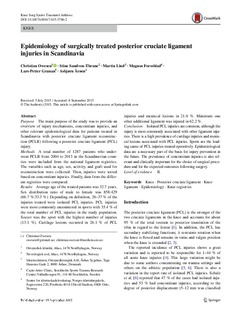| dc.contributor.author | Owesen, Christian | |
| dc.contributor.author | Sandven-Thrane, Stine | |
| dc.contributor.author | Lind, Martin | |
| dc.contributor.author | Forssblad, Magnus | |
| dc.contributor.author | Granan, Lars-Petter | |
| dc.contributor.author | Årøen, Asbjørn | |
| dc.date.accessioned | 2016-05-25T12:41:58Z | |
| dc.date.available | 2016-05-25T12:41:58Z | |
| dc.date.issued | 2015-09-19 | |
| dc.identifier.citation | Knee Surgery, Sports Traumatology, Arthroscopy. 2015, under utgivelse. doi:10.1007/s00167-015-3786-2 | nb_NO |
| dc.identifier.uri | http://hdl.handle.net/11250/2390430 | |
| dc.description | © The Author(s) 2015. Open Access. This article is distributed under the terms of the Creative Commons Attribution 4.0 International License (http://creativecommons.org/licenses/by/4.0/), which permits unrestricted use, distribution, and reproduction in any medium, provided you give appropriate credit to the original author(s) and the source, provide a link to the Creative Commons license, and indicate if changes were made. | nb_NO |
| dc.description.abstract | Purpose:
The main purpose of the study was to provide an overview of injury mechanisms, concomitant injuries, and other relevant epidemiological data for patients treated in Scandinavia with posterior cruciate ligament reconstruction (PCLR) following a posterior cruciate ligament (PCL) injury.
Methods:
A total number of 1287 patients who underwent PCLR from 2004 to 2013 in the Scandinavian counties were included from the national ligament registries. The variables such as age, sex, activity, and graft used for reconstruction were collected. Then, injuries were sorted based on concomitant injuries. Finally, data from the different registries were compared.
Results:
Average age of the treated patients was 32.7 years. Sex distribution ratio of male to female was 858:429 (66.7 %:33.3 %). Depending on definition, 26–37 % of the injuries treated were isolated PCL injuries. PCL injuries were most commonly encountered in sports with 35.4 % of the total number of PCL injuries in the study population. Soccer was the sport with the highest number of injuries (13.1 %). Cartilage lesions occurred in 26.1 % of PCL injuries and meniscal lesions in 21.0 %. Minimum one other additional ligament was injured in 62.2 %.
Conclusion:
Isolated PCL injuries are common, although the injury is most commonly associated with other ligament injuries. There is a high prevalence of cartilage injuries and meniscal lesions associated with PCL injuries. Sports are the leading cause of PCL injuries treated operatively. Epidemiological data are a necessary part of the basis for injury prevention in the future. The prevalence of concomitant injuries is also relevant and clinically important for the choice of surgical procedure and for the expected outcomes following surgery.
Level of evidence:
II. | nb_NO |
| dc.language.iso | eng | nb_NO |
| dc.publisher | Springer Verlag | nb_NO |
| dc.subject | knee | nb_NO |
| dc.subject | posterior cruciate ligament | nb_NO |
| dc.subject | knee ligament | nb_NO |
| dc.subject | epidemiology | nb_NO |
| dc.subject | knee registries | nb_NO |
| dc.title | Epidemiology of surgically treated posterior cruciate ligament injuries in Scandinavia | nb_NO |
| dc.type | Journal article | nb_NO |
| dc.type | Peer reviewed | nb_NO |
| dc.subject.nsi | VDP::Medical disciplines: 700 | nb_NO |
| dc.source.journal | Knee Surgery, Sports Traumatology, Arthroscopy | nb_NO |
| dc.description.localcode | Seksjon for idrettsmedisinske fag / Department of Sports Medicine | nb_NO |
